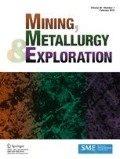Abstract
In this article, the cementation of major impurities from zinc sulphate leach solution by the addition of zinc dust was studied by considering different parameters including time, mesh size, and percentage of excess zinc dust. The output obtained from various experiments was utilized for the design of experiments. A multi-level categorical factorial design with a quadratic model was employed during this study. Results were predicted to minimize the concentration of impurity metals in the solution by altering the parameters. Furthermore, these predicted results were validated by performing another experiment. Successfully, it showed that the predicted and experimental data values were close to each other. The predicted optimized values were 40 min, 100% excess zinc dust, and 300 mesh size for copper; 42 min, 100% excess zinc dust, and 300 mesh size for cobalt; 37 min, 100% excess zinc dust, and 300 mesh size for cadmium; and 34 min, 100% excess zinc dust, and 300 mesh size zinc dust for nickel. At these optimized values, the experimental results showed 99.99%, 55.7%, 99.6%, and 76.6% cementation efficiencies for copper, cobalt, cadmium, and nickel respectively. The statistical design of experiments for the effective cementation of impurities corroborates the economic feasibility of optimizing parameters for the proposed process.









Similar content being viewed by others
References
Morgan SWK (1977) Zinc & Its Alloys, First. ed.
Abrasheva B, Karoleva V (1984) Classification of technological schemes for purification of solutions by cementation in the zinc production plants. Metallurgy, vol. 8, no. in bulgarian, pp. 39–41
Nelson A, Demopoulos GP, Houlachi G (2000) The effect of solution constituents and novel activators on cobalt cementation. Can Metall Q 39(2):175–186. https://doi.org/10.1179/cmq.2000.39.2.175
Raghavan R, Mohanan PK, Verma SK (1999) Modified zinc sulphate solution purification technique to obtain low levels of cobalt for the zinc electrowinning process. Hydrometallurgy 51(2):187–206. https://doi.org/10.1016/s0304-386x(98)00076-0
Dreher TM, Nelson A, Demopoulos GP, Filippou D (2001) Kinetics of cobalt removal by cementation from an industrial zinc electrolyte in the presence of Cu, Cd, Pb, Sb and Sn additives. Hydrometallurgy 60(2):105–116. https://doi.org/10.1016/S0304-386X(00)00152-3
González-Domínguez JA, Dreisinger DB (1997) Identifying research opportunities in zinc electrowinning. Jom 49(4):38–39. https://doi.org/10.1007/BF02914873
Van Arsdale GD (1953) Hydrometallurgy of Base Metals. McGraw-Hill.
Panão ASI, De Carvalho JMR, Correia MJN (2006) copper removal from sulphuric leaching solutions by cementation. 1–12.
Rao MD, Meshram A, Verma HR, Singh KK, Mankhand TR (2020) Study to enhance cementation of impurities from zinc leach liquor by modifying the shape and size of zinc dust. Hydrometallurgy 195 https://doi.org/10.1016/j.hydromet.2020.105352.
Rao MD, Singh KK, Mankhand TR (2019)“Purification of zinc sulphate electrolyte with modified zinc dust and kinetics of cadmium cementation,” in IMPC 2018 - 29th International Mineral Processing Congress, , pp. 2560–2568.
Boyanov BS, Konareva VV, Kolev NK (2004) Purification of zinc sulfate solutions from cobalt and nickel through activated cementation. Hydrometallurgy 73:163–168. https://doi.org/10.1016/j.hydromet.2003.09.002
Wen J, Jiang T, Liu Y, Xue X (2019) Extraction behavior of vanadium and chromium by calcification roasting-acid leaching from high chromium vanadium slag: optimization using response surface methodology. Miner Process Extr Metall Rev 40(1):56–66. https://doi.org/10.1080/08827508.2018.1481059
Karimi P, Abdollahi H, Aslan N, Noaparast M, Shafaei SZ (2011) Application of response surface method and central composite design for modeling and optimization of gold and silver recovery in cyanidation process. Miner Process Extr Metall Rev 32(1):1–16. https://doi.org/10.1080/08827508.2010.508828
Zakrzewska-Koltuniewicz G, Herdzik-Koniecko I, Cojocaru C, Chajduk E (2014) Experimental design and optimization of leaching process for recovery of valuable chemical elements (U, La, V, Mo, Yb and Th) from low-grade uranium ore. J Hazard Mater 275:136–145. https://doi.org/10.1016/j.jhazmat.2014.04.066
Anand A, Singh R, Ghosh MK, Sanjay K (2018) Factorial design for process optimization and generation of kinetic data for yttrium and europium leaching. Miner Process Extr Metall Trans Inst Min Metall 130(1):1–9. https://doi.org/10.1080/25726641.2018.1505209
Yahiaoui I, Aissani-Benissad F, Aït-Amar H (2010) Optimization of silver cementation yield in fixed bed reactor using factorial design and central composite design. Can J Chem Eng 88(6):1099–1106. https://doi.org/10.1002/cjce.20348
Rao MD, Singh KK, Morrison CA, Love JB (2021) Optimization of process parameters for the selective leaching of copper , nickel and isolation of gold from obsolete mobile phone PCBs. Clean. Eng. Technol 4, no. June, p. 100180, https://doi.org/10.1016/j.clet.2021.100180.
Abbasi P, Shayesteh K, Fard VV, Hosseini M (2021) Optimization of nickel removal process from zinc sulfate solution using central composite design of experiments 8(1):17–28, https://doi.org/10.30473/ijac.2021.57821.1181.
Keleş O (2009) An optimization study on the cementation of silver with copper in nitrate solutions by Taguchi design. Hydrometallurgy 95(3–4):333–336. https://doi.org/10.1016/j.hydromet.2008.07.006
Moghaddam J, Sarraf-Mamoory R, Abdollahy M, Yamini Y (2006) Purification of zinc ammoniacal leaching solution by cementation: determination of optimum process conditions with experimental design by Taguchi’s method. Sep Purif Technol 51(2):157–164. https://doi.org/10.1016/j.seppur.2006.01.012
Yahiaoui I, Aissani-Benissad F (2010) Experimental design for copper cementation process in fixed bed reactor using two-level factorial design. Arab J Chem 3(3):187–190. https://doi.org/10.1016/j.arabjc.2010.04.009
Djoudi W, Aissani-Benissad F, Bourouina-Bacha S (2007) Optimization of copper cementation process by iron using central composite design experiments. Chem Eng J 133(1–3):1–6. https://doi.org/10.1016/j.cej.2007.01.033
Karavasteva M (2001) The effect of certain surfactants on the cementation of cobalt from zinc sulphate solutions by suspended zinc particles in the presence of copper or antimony. Can Metall Q 40(2):179–184. https://doi.org/10.1179/000844301794388416
Acknowledgements
Authors express thanks to Head, Department of Metallurgical Engineering, Indian Institute of Technology (Banaras Hindu University), Varanasi, India, for providing the needful workplace and analytical support to pursue this research work. They also express their gratitude to Dr. Arunabh Mesharam, Ms. Pushpa Gautam, Mr. Seby Varghese, Mr. Kumar Saurabh, and Mr. Chinmay Rajendra Dhake, Indian Institute of Technology (BHU), for their constant support.
Author information
Authors and Affiliations
Corresponding author
Ethics declarations
Conflict of Interest
The authors declare no competing interests.
Additional information
Publisher's Note
Springer Nature remains neutral with regard to jurisdictional claims in published maps and institutional affiliations.
Rights and permissions
About this article
Cite this article
Singh, A.R., Joseph, A.S., Rao, M.D. et al. An Assessment of Parameters for Cementation of Impurities from Zinc Sulphate Leach Solution by a Statistical Design. Mining, Metallurgy & Exploration 39, 2257–2271 (2022). https://doi.org/10.1007/s42461-022-00656-3
Received:
Accepted:
Published:
Issue Date:
DOI: https://doi.org/10.1007/s42461-022-00656-3




